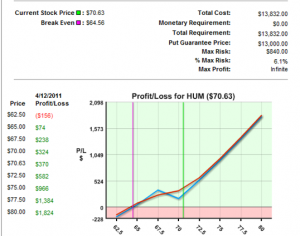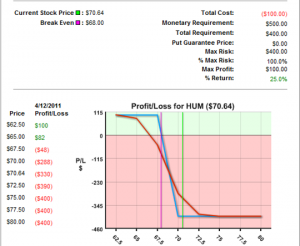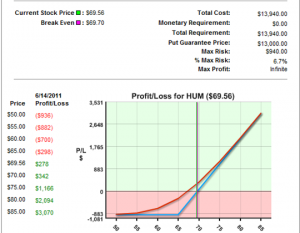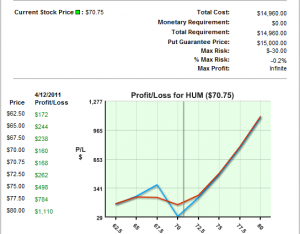Post: The Strange Secret Behind Riskless Spread Trading.
Word Count: About 1300 words
Time to Read: 5 1/2 WELL-invested minutes
How to do a Spread Trade Without the Risk
Good Morning Traders! ‘Nother installment from RadioActive Trading about how to limit risk, enhance returns, and bulletproofing your portfolio.
So, “Riskless Spread Trades?” Seriously, it sounds a lot like those spammy emails or classified ads that say “Government Loans — Never Pay Back.”
Yeah, and I gots oceanfront property in AZ I wanna sell to ya 😉
But if it WERE possible to set up a spread trade that takes a premium, but can’t ever hurt you– wouldn’t it make sense to find out how?
Read on.
Actually, MANY Trades Can Be Done Risklessly
That’s true. What makes a trade risky or not is its context. For example, I did a bet once with my friend Emil (this is a true story). We were at a coffee shop and I told him I absolutely, positively, every single time… could ‘call’ what a tossed coin would do when he tossed it in the air, as long as he didn’t mess with it after he tossed it.
“You’re saying you can call the toss?”
“I’ll tell you exactly what it will do, after you toss it, but before it hits the ground. And I’ll betcha a Grande Mocha that I get it exactly right.”
He took the bet.
Then he tossed the coin.
I called out, “Hit the floor, roll around a bit, stop.”
Emil groaned. He knew he’d been had.
Tricky, but What About Trading Options Without Risk?
Well, if you trade options at all you probably got introduced to it with a completely riskless play… without knowing it was completely riskless.
I’m talking about a short call here.
When you do a short call, by itself, we call that a “NAKED” call.
Naked as in, nothing ‘covering’ the call. Sell a call… get some premium in your account… it’s a happy day, right?
Well, yeah. UNLESS your underlying stock goes up. THEN you have a problem because the short call obligates you to deliver stock at a low price, when it fact it’s only available at a high price. So you gotta go on the open market and buy stock high, only to sell it low.
And that sucks.
See? Short calls are risky, right? In fact the only riskier thang you can do in the stock market than sell a short call… is to sell two short calls.
But You Said I’ve Probably DONE a RISKLESS Options Play…
Yes I did. Because when you got qualified to do options trades, it was probably with covered calls. Meaning that you were allowed to sell calls short, provided that you already owned the stock.
In other words, a “covered” call.
Your ownership of the stock eliminates all the risk that normally would go against you.
Like I said, it’s the context that makes a play risky or not. Emil thought I was making a bet with him that it was gonna be heads or tails. But the context of the bet was that I could predict what the coin would do. And I did, accurately.
When the context of your short call includes ownership of the stock… then the risk inherent in the short call goes away.
Hence, you have probably already done a riskless options play. “Why, sure,” yo might be saying. “But there still is risk involved in owning the stock.
Well. Yes. But vee have vays of dealing vith that…
How to Eliminate ALL Capital Risk from Trading
In other posts you’ve seen the phenomenon of “Bulletproofing“– using Income Methods to alter a protective put trade so that the cost basis for the protective put is less than the strike price of the put.
For example, say you own shares of XYZ with a cost basis of $50, and a long-term $55 put option for a cost of $7.
That’s $57 for an instrument that’s worth $55 at least, but could actually go higher from there.
Okay.
Now, by using a short-term Income Method, say you capture $2 premium. The net cost basis of your stock plus put… which HAD been $57… is reduced to $55. And you still are holding a $55 put option.
Can you lose in this context?
Nope.
What else is possible, I wonder?
A Truly Riskless Spread Trade
In the above example of a short call, we saw that doing the call itself.. BY itself… was risky. But doing the short call in the context of the ownership of stock eliminated all the risk, at least from the call.
Let’s look at a different play, shall we?
Here’s the risk/reward graph of a Bear Call Spread:
$400 AT RISK, ‘nested’ within…
It looks from this graph as though the Bear Call Spread risks four times as much as it takes in.
And it would… IF it weren’t for the fact that we also own the stock.
Here’s what the stock plus put ownership looks like:
In the context of owning stock plus a put option, the Bear Call Spread won’t have any risk remaining at all.
Doing a Bear Call Spread captures income which might actually come back and ‘bite’ ya if the stock’s price goes up.
But in the context that includes owning stock at a lower cost basis, that spread has no risk.
It’s a little like the “fixed” bet that I made with Emil: I wasn’t betting that the coin would be heads or tails, only that it would go down.
Similarly, I’m not betting that the stock will go up or down… I’m taking a premium now from the sale of my Bear Call Spread, and I’m doing it in the context of owning the stock so if it goes up… shoot, there is still an unlimited upside.
Here’s what the combination of those two plays (the long term married put and the short term bear call spread) looks like.

All four legs combined: stock, put, short calls, long calls. You cannot lose on the bear call spread without winning bigger on the stock!
If you’ll note..! The Bear Call Spread cannot go against. You get to keep the credit suplied, whether the stock goes up, down, or sideways.
The risk that had been present for doing the Bear Call Spread was dependent on the fact that we didn’t own the stock. But if we do own the stock… That risk goes away.
In the context of owning stock, there is no risk to doing a Bear Call Spread if the strike price of the short call is higher than the cost basis for the stock.
Here is the strange secret behind doing Riskless Spread Trades: It’s RISKLESS to do the trade when you are not betting on either outcome.
The facts that:
1) there is a long-term put option protecting the stock;
and
2) the Bear Call Spread can be done multiple times because it’s always a near term one;
…means that you might do apply this principle over and over. By a series of Bear Call Spreads (or another combination… there are ELEVEN “Income Methods” you might completely eliminate risk altogether.
Check it:
Well, traders… whaddya think of today’s post?
Do ya think you could stand to be in a position like the one to the left… Bulletproof, meaning heads you win, tails you can’t lose?
I’d love to offer you a free mini-course that’ll walk you through exactly how you may get to this “Bulletproof” status within your own account.
Click me! <== to get the free mini-course, and to get on the waitlist for “The Blueprint“.
Oh, and if you found this post useful and/or intriguing… maybe a second set of eyes should see it too. Bonus karma points for you for sharing and commenting!
😉
Okay Traders. I’m off like a prom dress. Time to go get ready for today’s webinar.
Happy Trading,
Kurt



 I'm Kurt Frankenberg, and I have discovered how to truly put the odds on the side on the individual investor.
I'm Kurt Frankenberg, and I have discovered how to truly put the odds on the side on the individual investor.
Hello Kurt,
I am a blue print owner, but I am still confused about this sentence “there is no risk to doing a Bear Call Spread if the strike price of the short call is higher than the cost basis for the stock”
I have seen you used the same sentence in IM#11. I have seen some of your videos where the short bear call strike is below the protective put…so, does this sentence mean that you are not taking any risk if the premium received from call is enough to cancel the total risk left in the Married Put and you are not expecting any direction outcome from the stock? Please post cost basis example if possible.
We answered Jay’s question in more detail via email as he is a Blueprint owner. If an IM #6 is used where the short call is below the cost basis, you may end up in a situation where you have two ways to lose. This is why The Blueprint is an important reference to own as we describe all of the rules, “do’s” and “dont’s” for all 11 income methods.
hey Kurt just read this again after reading THE SKETCH and listening to “webinars and radio shows for rat” again. As usual everything was “RAT on!!” get it?.. rat on??? radioactive trading and right on together??? oh never mind. (LOL)
BWAHAHAHAHAHA!
Yes Ziggy, RAT on!
😉
[…] The Strange Secret Behind Riskless Spread Trading […]
howdy !
Hello Kurt,
The loss of the spread is less than the gain of the married put, that’s why it’s “riskless”. However, if you take the full loss of the spread in expiration, and you are still holding the married put position, after that if the stock price drops, then the original “gain” is gone, so the loss of the spread is not covered, and the risk of the whole position increases, right?
So it’s not always riskless?
[…] The Strange Secret Behind Riskless Spread Trading […]